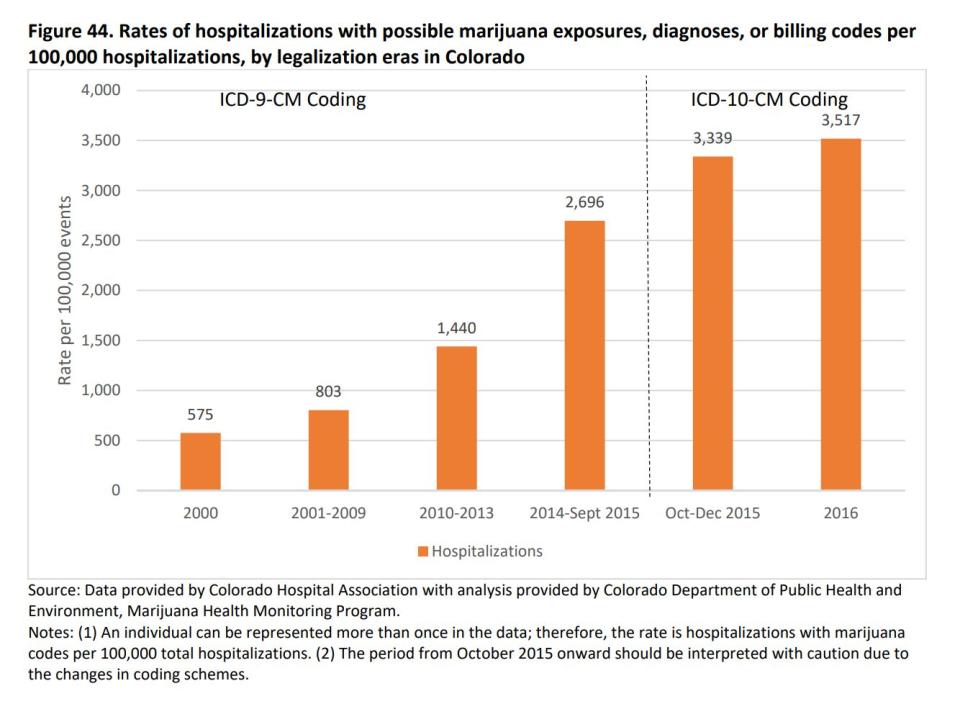How legalized cannabis changed Colorado in the past five years
The 5-year experiment that is Colorado’s pioneering legalization of recreational marijuana now has enough data for more than conjecture to debate its success.
The state’s first dispensaries began legal recreational sales on January 1, 2014. In 2014, combined recreational and medical sales totaled $683.5 million, and are expected to top $1.5 billion in 2018. Over the 5-year period, recreational sales generated 78% of sales revenue. The most recently published sales data shows combined 2018 sales though October of $1.27 billion.
$247 million in tax revenue
Tax revenues jumped 266% during the period, from $67 million in 2014 to $247.4 million in 2017. Colorado’s tax revenues have risen each year since recreational legalization, and currently represent about 1% of the state’s 2018 - 2019 fiscal year budget.
Marijuana taxes are spent on public school projects, human services, public affairs, agriculture, labor and employment, judicial affairs, health care policy, transportation and regulatory affairs.
The financial data, read together with a social impact report released this week by Colorado’s Department of Criminal Justice, is insightful for Colorado and states considering legalization.
The report presents a mixed bag of encouraging and frustrating data.
The number of marijuana-related arrests during the 5-year period, shows overall arrests decreased, including for African-Americans, though African-Americans were arrested for such offenses at double the rate of whites.
DUI traffic citations with marijuana-impaired drivers increased 3%. In a subset of arrest data from 2016, where blood tests were performed, 73% returned a positive screen for cannabinoids
“The number of fatalities with cannabinoid‐only or cannabinoid‐in‐combination positive drivers increased 153%, from 55 in 2013 to 139 in 2017,” the report states, going on to note that “detection of cannabinoid in blood is not an indicator of impairment but only indicates presence in the system.” Fatal traffic accidents involving a THC-positive driver, on the other hand, decreased 5%.
Cannabinoids characterize both THC and CBD. Cannabidiol “CBD” is a non-psychoactive biochemical found in hemp and marijuana plants. Tetrahydrocannaabinol “THC” is the psychoactive biochemical found in marijuana. Both biochemicals are cannabinoids that interact with neurotransmitters, known as the endocannabinoid system.

Marijuana-related hospitalizations, including possible marijuana exposures, diagnoses, or billing codes, increased from 575 in 2000 to 3,517 in 2016. Emergency room visits and calls to poison control related to marijuana increased.
The numbers are likely to disappoint lawmakers and politicians who tout recreational legalization as a cure for discriminatory criminal justice practices.
Already, New York City mayor Bill de Blasio, and recent supporter of legalized marijuana, New York state Governor Andrew Cuomo, both who have stated criminal justice reform as a reason for supporting legalization, are facing pushback from the New York State Association of County Health Officials.
Positive social impact
The good news from the social impact findings include an increase in Colorado's high school graduation rates, along with no change in the number of middle school and high school students reporting marijuana use.
Court filings related to marijuana declined 55% between from 11,753 in 2012 to 5,288 in 2017, according to the report.
While marijuana traffic citations increased, the total number of DUI citations decreased from 5,705 in 2014 to 4,849 in 2017.
Adults who reported using marijuana within the past 30 days increased 2%. The number of men who reported use within 30 days -- 19.8% -- was nearly double that of women -- 11%.
The report cautions that its data should be read with consideration for changes that legalization brings to social acceptance of marijuana use.
“[L]egalization may result in reports of increased use, which may be a function of the decreased stigma and legal consequences associated with use rather than actual changes in use patterns,” the report said. “Likewise, those reporting to poison control, emergency departments, or hospitals may feel more comfortable discussing their recent use or abuse of marijuana for purposes of treatment.”
—
Alexis Keenan is a New York-based reporter for Yahoo Finance. She previously produced live news for CNN and is a former litigation attorney. Follow her on Twitter at @alexiskweed
Read more:
California’s new female board mandate is ripe for constitutional challenge
Hemp entrepreneurs say big retailers unfairly dominate online ads
Lawyer: Google’s new sexual harassment policy is a ‘bait-and-switch’
Google’s search leaves users in the dark: DuckDuck GO CEO
Apple faces massive legal risk, and it’s not about iPhone demand or tariffs
Weed is legal in 3 more states — here’s what to expect from the new laws
Follow Yahoo Finance on Twitter, Facebook, Instagram, Flipboard, LinkedIn, YouTube, andreddit.

 Yahoo Finance
Yahoo Finance 